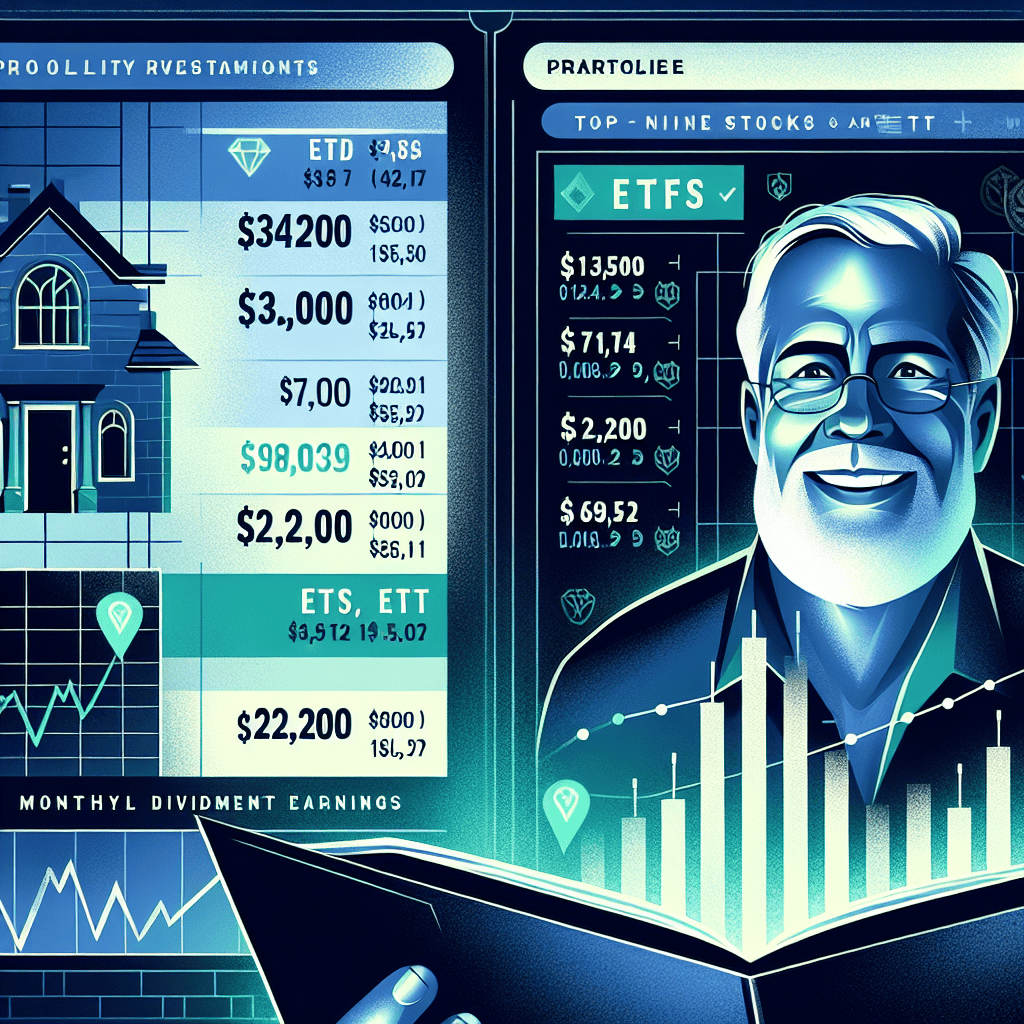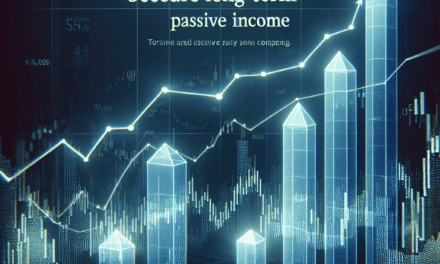“Unlocking Wealth: A 48-Year-Old’s Guide to Earning $2,200 Monthly with a $378K Dividend Portfolio”
Introduction
A 48-year-old investor has strategically built a robust portfolio valued at $378,000, generating a steady monthly income of $2,200 through dividends. This impressive financial achievement is the result of carefully selecting a mix of high-performing stocks and exchange-traded funds (ETFs) that prioritize dividend yields. By focusing on a diversified array of assets, the investor has not only secured a reliable income stream but also positioned the portfolio for potential growth. The following overview highlights the top nine stocks and ETFs that form the backbone of this income-generating portfolio, offering insights into the strategies and selections that have contributed to its success.
Understanding Dividend Investing: A 48-Year-Old’s Journey to $2,200 Monthly Income
Dividend investing has long been a favored strategy for those seeking a steady income stream, and the journey of a 48-year-old investor who has built a $378,000 portfolio yielding $2,200 monthly in dividends offers valuable insights into this approach. This investor’s experience underscores the importance of strategic stock and ETF selection, patience, and a clear understanding of one’s financial goals. By examining the top nine stocks and ETFs in this portfolio, we can glean lessons on how to effectively harness the power of dividends.
To begin with, dividend investing involves purchasing shares in companies that regularly distribute a portion of their earnings to shareholders. This strategy not only provides a source of passive income but also offers the potential for capital appreciation. The investor in question has carefully curated a portfolio that balances both high-yield stocks and growth-oriented ETFs, ensuring a diversified income stream. This approach mitigates risk while maximizing returns, a crucial consideration for anyone looking to replicate such success.
Among the top holdings in this portfolio are several well-established companies known for their reliable dividend payments. These include blue-chip stocks like Johnson & Johnson and Procter & Gamble, both of which have a long history of increasing dividends annually. Such companies are often considered safe bets in the world of dividend investing due to their robust business models and consistent cash flow. By including these stalwarts, the investor secures a foundation of stability and predictability in their income.
In addition to individual stocks, the portfolio also features a selection of dividend-focused ETFs. These funds offer exposure to a broad range of dividend-paying companies, providing diversification and reducing the impact of any single stock’s performance on the overall portfolio. Notable ETFs in this collection include the Vanguard Dividend Appreciation ETF and the iShares Select Dividend ETF. These funds are designed to track indices that prioritize companies with a strong track record of dividend growth, thus aligning with the investor’s long-term income objectives.
Furthermore, the investor’s strategy highlights the importance of reinvesting dividends to compound returns over time. By automatically reinvesting dividends, the portfolio benefits from the power of compounding, where earnings generate additional earnings. This approach not only accelerates portfolio growth but also increases future dividend income, creating a virtuous cycle of wealth accumulation.
Moreover, the investor’s journey emphasizes the need for regular portfolio review and adjustment. As market conditions and personal financial goals evolve, so too should one’s investment strategy. This investor periodically assesses their holdings to ensure alignment with their income targets and risk tolerance. Such diligence is essential in maintaining a portfolio that continues to meet financial objectives over the long term.
In conclusion, the experience of this 48-year-old investor serves as a testament to the potential of dividend investing as a means of generating substantial passive income. By carefully selecting a mix of high-quality stocks and ETFs, reinvesting dividends, and regularly reviewing their portfolio, this individual has successfully built a $378,000 portfolio that yields $2,200 monthly. For those considering a similar path, this story offers both inspiration and practical guidance on how to achieve financial independence through dividends.
Building a $378,000 Portfolio: Key Strategies for Dividend Success
Building a successful investment portfolio that generates consistent income is a goal for many investors, and the story of a 48-year-old individual who has achieved this with a $378,000 portfolio earning $2,200 monthly in dividends offers valuable insights. This achievement is not merely the result of luck but rather a combination of strategic planning, disciplined investing, and a focus on dividend-paying stocks and ETFs. By examining the strategies employed, other investors can glean important lessons to apply to their own financial journeys.
To begin with, the foundation of this portfolio is built on diversification, a critical strategy in mitigating risk and ensuring steady income. By spreading investments across various sectors and industries, the investor reduces the impact of any single company’s poor performance on the overall portfolio. This approach not only stabilizes income but also positions the portfolio to benefit from growth in different areas of the economy. The inclusion of both individual stocks and exchange-traded funds (ETFs) further enhances diversification, as ETFs inherently contain a basket of securities.
Moreover, the focus on dividend-paying stocks is a deliberate choice that aligns with the goal of generating regular income. Dividends provide a reliable stream of cash flow, which can be particularly appealing for those seeking financial independence or supplementing their income. The investor’s selection of top-performing dividend stocks and ETFs is based on thorough research and analysis, considering factors such as dividend yield, payout ratio, and the company’s history of dividend payments. This careful selection process ensures that the portfolio is composed of financially sound companies with a track record of rewarding shareholders.
In addition to diversification and dividend focus, the investor emphasizes the importance of a long-term perspective. By adopting a buy-and-hold strategy, the portfolio benefits from the power of compounding, where reinvested dividends contribute to exponential growth over time. This approach requires patience and discipline, as it involves weathering market fluctuations without succumbing to the temptation of short-term trading. The investor’s commitment to this strategy is evident in the consistent growth of the portfolio’s value and income generation.
Furthermore, regular portfolio reviews and adjustments are integral to maintaining its success. The investor periodically assesses the performance of each holding, ensuring that it continues to align with their financial goals. This proactive management involves rebalancing the portfolio as needed, which may include selling underperforming assets and reinvesting in more promising opportunities. By staying informed about market trends and economic developments, the investor can make informed decisions that enhance the portfolio’s resilience and growth potential.
In conclusion, the story of this 48-year-old investor’s $378,000 portfolio serves as an inspiring example of how strategic planning and disciplined investing can lead to significant financial achievements. Through diversification, a focus on dividend-paying stocks, a long-term perspective, and regular portfolio management, the investor has created a robust income-generating asset. For those looking to build their own dividend-focused portfolios, these strategies offer a roadmap to success, demonstrating that with careful planning and execution, financial goals are within reach.
Top 9 Stocks and ETFs for Reliable Dividend Income
In the realm of personal finance, the pursuit of reliable dividend income has become a cornerstone strategy for many investors seeking to supplement their earnings. A 48-year-old investor recently shared insights into their $378,000 portfolio, which generates an impressive $2,200 in monthly dividends. This portfolio is strategically composed of a mix of stocks and exchange-traded funds (ETFs) that prioritize consistent dividend payouts. By examining the top nine holdings within this portfolio, we can glean valuable insights into constructing a robust dividend-focused investment strategy.
To begin with, the portfolio includes several blue-chip stocks known for their stability and reliable dividend payments. Among these is Johnson & Johnson, a stalwart in the healthcare sector. With its diversified product lines and strong market presence, Johnson & Johnson has consistently delivered dividends, making it a favored choice for income-focused investors. Similarly, Procter & Gamble, a leader in consumer goods, is another cornerstone of this portfolio. Its extensive range of household products ensures steady cash flow, which translates into dependable dividend distributions.
Transitioning to the financial sector, the portfolio features JPMorgan Chase, a banking giant with a long history of dividend payments. Despite the cyclical nature of the financial industry, JPMorgan Chase has demonstrated resilience, maintaining its dividend payouts even during economic downturns. This resilience is mirrored by another financial holding, Bank of America, which has also proven its ability to generate consistent income for shareholders.
In addition to individual stocks, the portfolio incorporates ETFs to enhance diversification and income stability. The Vanguard High Dividend Yield ETF is a prominent inclusion, offering exposure to a broad array of high-yielding stocks. This ETF is particularly appealing for those seeking to mitigate risk while still capturing attractive dividend returns. Similarly, the Schwab U.S. Dividend Equity ETF provides a diversified approach to dividend investing, focusing on U.S. companies with a strong track record of dividend growth.
Moreover, the portfolio includes the iShares Select Dividend ETF, which targets companies with a history of paying dividends. This ETF is designed to provide investors with a steady income stream, making it a suitable choice for those prioritizing dividend reliability. Another noteworthy ETF is the SPDR S&P Dividend ETF, which tracks the S&P High Yield Dividend Aristocrats Index. This index comprises companies that have consistently increased their dividends for at least 20 consecutive years, underscoring the ETF’s focus on dividend growth and stability.
Rounding out the portfolio are two additional stocks that contribute to its robust dividend income. Realty Income Corporation, a real estate investment trust (REIT), is renowned for its monthly dividend payments, appealing to investors seeking regular income. Its portfolio of commercial properties provides a stable revenue stream, supporting its reliable dividend distributions. Lastly, AT&T, a telecommunications giant, is included for its substantial dividend yield. Despite facing challenges in recent years, AT&T remains committed to returning value to shareholders through dividends.
In conclusion, this carefully curated portfolio exemplifies a strategic approach to generating reliable dividend income. By combining blue-chip stocks with diversified ETFs, the investor has constructed a resilient portfolio capable of weathering market fluctuations while delivering consistent returns. For those seeking to emulate this strategy, focusing on companies with strong fundamentals and a history of dividend payments is paramount. As demonstrated by this 48-year-old investor, a well-balanced portfolio can serve as a dependable source of income, providing financial security and peace of mind.
How to Choose Dividend Stocks: Insights from a Successful Investor

When it comes to building a robust dividend portfolio, the insights of seasoned investors can be invaluable. One such investor, a 48-year-old with a $378,000 portfolio generating $2,200 in monthly dividends, offers a compelling blueprint for those looking to achieve similar financial success. The key to his strategy lies in the careful selection of dividend stocks and exchange-traded funds (ETFs), which provide a steady stream of income while also offering potential for capital appreciation. Understanding the criteria he uses to choose these investments can provide a roadmap for others seeking to enhance their own portfolios.
First and foremost, this investor emphasizes the importance of dividend yield and payout ratio. A high dividend yield can be attractive, but it is crucial to ensure that the payout ratio is sustainable. A payout ratio, which is the percentage of earnings paid to shareholders in dividends, should ideally be below 60%. This indicates that the company retains enough earnings to reinvest in its growth, ensuring the sustainability of its dividend payments. By focusing on companies with a balanced approach to dividends and growth, investors can mitigate the risk of dividend cuts, which can significantly impact income streams.
In addition to yield and payout ratio, the investor highlights the significance of a company’s dividend history. Companies with a long track record of paying and increasing dividends are often more reliable. This history suggests a commitment to returning value to shareholders and an ability to weather economic downturns. Such companies are typically well-established with stable cash flows, making them less susceptible to market volatility. By prioritizing stocks with a strong dividend history, investors can build a portfolio that is resilient in the face of economic uncertainties.
Moreover, diversification is a cornerstone of this investor’s strategy. By spreading investments across various sectors and industries, the portfolio is better protected against sector-specific downturns. This approach not only reduces risk but also capitalizes on growth opportunities across different areas of the economy. For instance, while technology stocks may offer high growth potential, including utilities and consumer staples can provide stability and consistent dividends. This balanced approach ensures that the portfolio remains robust, regardless of market conditions.
Furthermore, the investor underscores the importance of regular portfolio reviews. The financial landscape is constantly evolving, and what may be a strong investment today might not hold the same promise tomorrow. By periodically assessing the performance of each stock and ETF, investors can make informed decisions about whether to hold, sell, or buy more shares. This proactive approach allows for adjustments that align with changing market dynamics and personal financial goals.
Lastly, the investor advises patience and a long-term perspective. Dividend investing is not a get-rich-quick scheme but rather a strategy that rewards those who are willing to wait. By reinvesting dividends and allowing the power of compounding to work over time, investors can significantly enhance their wealth. This disciplined approach, combined with the careful selection of high-quality dividend stocks and ETFs, can lead to substantial financial rewards.
In conclusion, the insights from this successful investor provide a valuable framework for those looking to build a dividend portfolio. By focusing on sustainable yields, a strong dividend history, diversification, regular reviews, and a long-term perspective, investors can create a portfolio that not only generates consistent income but also grows over time.
The Power of Compounding: Growing a Dividend Portfolio Over Time
The power of compounding is a fundamental principle in the world of investing, and it plays a crucial role in the growth of a dividend portfolio over time. A 48-year-old investor recently shared insights into their $378,000 portfolio, which generates an impressive $2,200 in monthly dividends. This achievement underscores the potential of strategic investing and the benefits of a disciplined approach to building wealth. By focusing on a combination of individual stocks and exchange-traded funds (ETFs), this investor has effectively harnessed the power of compounding to create a reliable income stream.
To understand how this portfolio was constructed, it is essential to examine the underlying components that contribute to its success. The investor has carefully selected a mix of nine stocks and ETFs, each chosen for their ability to provide consistent dividend payouts and potential for capital appreciation. This diversified approach not only mitigates risk but also ensures a steady flow of income, which is reinvested to further enhance the compounding effect.
Among the top holdings in this portfolio are well-established companies known for their robust dividend histories. These include blue-chip stocks that have demonstrated resilience through various market cycles, offering both stability and growth potential. By investing in such companies, the investor benefits from regular dividend payments, which are reinvested to purchase additional shares. Over time, this reinvestment strategy amplifies the compounding effect, leading to exponential growth in both the portfolio’s value and its income-generating capacity.
In addition to individual stocks, the inclusion of ETFs provides an added layer of diversification. ETFs offer exposure to a broad range of sectors and industries, reducing the impact of volatility in any single area. This strategic allocation allows the investor to capture the overall growth of the market while still benefiting from the dividends paid by the underlying assets. Furthermore, ETFs often come with lower expense ratios compared to mutual funds, making them a cost-effective choice for long-term investors.
The success of this portfolio is not solely attributed to the selection of high-quality dividend-paying stocks and ETFs. It also hinges on the investor’s commitment to a long-term investment horizon. By maintaining a focus on the future and resisting the temptation to react to short-term market fluctuations, the investor has allowed the power of compounding to work its magic. This disciplined approach is crucial, as it enables the portfolio to recover from downturns and capitalize on periods of growth.
Moreover, the investor’s strategy highlights the importance of regular contributions to the portfolio. By consistently adding funds, even in small amounts, the investor accelerates the compounding process. These additional investments increase the number of shares owned, which in turn boosts the amount of dividends received. Over time, this cycle of reinvestment and contribution creates a snowball effect, leading to substantial growth in both income and portfolio value.
In conclusion, the 48-year-old investor’s $378,000 portfolio serves as a testament to the power of compounding and the effectiveness of a well-structured dividend strategy. By carefully selecting a mix of stocks and ETFs, maintaining a long-term perspective, and consistently reinvesting dividends, the investor has successfully built a portfolio that generates $2,200 in monthly income. This achievement underscores the potential for individuals to grow their wealth through disciplined investing and the strategic use of compounding over time.
Risk Management in Dividend Investing: Lessons from a $378,000 Portfolio
In the realm of dividend investing, risk management is a crucial component that can significantly influence the success of a portfolio. A 48-year-old investor recently shared insights into their $378,000 portfolio, which generates a steady $2,200 in monthly dividends. This portfolio, comprising a mix of nine carefully selected stocks and ETFs, offers valuable lessons in balancing risk and reward. By examining the strategies employed in this portfolio, investors can gain a deeper understanding of how to manage risk while pursuing income through dividends.
One of the primary strategies evident in this portfolio is diversification. By spreading investments across different sectors and asset classes, the investor mitigates the risk associated with any single stock or industry downturn. This approach is particularly important in dividend investing, where reliance on a few high-yield stocks can expose the portfolio to significant volatility. The inclusion of both individual stocks and ETFs further enhances diversification, as ETFs inherently provide exposure to a broader range of securities.
Moreover, the selection of stocks and ETFs in this portfolio reflects a focus on quality and stability. The investor has chosen companies with strong financials, consistent dividend histories, and solid growth prospects. This emphasis on quality helps reduce the risk of dividend cuts, which can be detrimental to an income-focused strategy. By prioritizing companies with a track record of maintaining or increasing dividends, the investor ensures a more reliable income stream.
In addition to diversification and quality, the portfolio demonstrates the importance of regular monitoring and rebalancing. Market conditions and company performances can change, affecting the risk profile of a portfolio. By periodically reviewing and adjusting their holdings, the investor can respond to these changes and maintain an optimal balance between risk and return. This proactive approach allows for the identification of underperforming assets and the reallocation of capital to more promising opportunities.
Furthermore, the investor’s strategy highlights the significance of understanding one’s risk tolerance. Each investor has a unique capacity for risk, influenced by factors such as age, financial goals, and investment horizon. By aligning the portfolio with their risk tolerance, the investor can make informed decisions that support their long-term objectives. This alignment is crucial in dividend investing, where the pursuit of high yields must be balanced against the potential for capital loss.
Another key lesson from this portfolio is the value of patience and a long-term perspective. Dividend investing is not a get-rich-quick strategy; rather, it requires time for compounding to work its magic. By maintaining a long-term focus, the investor can weather short-term market fluctuations and benefit from the steady accumulation of dividends. This patience is essential in building a sustainable income stream that can support financial goals over time.
In conclusion, the $378,000 portfolio generating $2,200 in monthly dividends offers a wealth of insights into effective risk management in dividend investing. Through diversification, a focus on quality, regular monitoring, alignment with risk tolerance, and a long-term perspective, the investor has crafted a strategy that balances income generation with risk mitigation. These principles serve as a valuable guide for anyone seeking to navigate the complexities of dividend investing while minimizing potential pitfalls.
Achieving Financial Independence with Dividends: A 48-Year-Old’s Story
Achieving financial independence is a goal many aspire to, yet few manage to realize. For one 48-year-old investor, this dream has become a reality through a carefully curated portfolio that generates a steady stream of income. With a total value of $378,000, this portfolio yields approximately $2,200 monthly in dividends, providing a reliable source of passive income. The investor’s strategy focuses on a mix of individual stocks and exchange-traded funds (ETFs), each selected for their potential to deliver consistent returns.
The journey to financial independence began with a disciplined approach to saving and investing. Over the years, the investor prioritized contributions to retirement accounts and taxable brokerage accounts, gradually building a diversified portfolio. This methodical approach underscores the importance of patience and long-term planning in wealth accumulation. By reinvesting dividends and maintaining a focus on growth and income, the investor was able to harness the power of compounding, which significantly contributed to the portfolio’s growth.
Central to this strategy is the selection of nine key stocks and ETFs, each chosen for their strong dividend history and potential for capital appreciation. Among these, blue-chip stocks play a pivotal role, offering stability and reliable dividend payouts. Companies such as Johnson & Johnson and Procter & Gamble are staples in the portfolio, known for their resilience and ability to weather economic downturns. These stocks provide a solid foundation, ensuring a steady flow of income even during market volatility.
In addition to individual stocks, the portfolio includes several ETFs that offer diversification across various sectors and asset classes. For instance, the Vanguard Dividend Appreciation ETF is a core holding, known for its focus on companies with a history of increasing dividends. This ETF provides exposure to a broad range of industries, reducing risk while enhancing potential returns. Similarly, the Schwab U.S. Dividend Equity ETF is another key component, selected for its emphasis on high-quality U.S. companies with strong dividend yields.
The investor’s approach also highlights the importance of balancing growth and income. While dividend stocks and ETFs form the backbone of the portfolio, there is also room for growth-oriented investments. This includes companies in the technology sector, which, although not traditionally known for high dividends, offer significant potential for capital gains. By maintaining a mix of income-generating and growth-focused assets, the portfolio is well-positioned to benefit from both current income and future appreciation.
Moreover, the investor emphasizes the significance of regular portfolio reviews and adjustments. As market conditions change, so too do the prospects of individual investments. By staying informed and making strategic adjustments, the investor ensures that the portfolio remains aligned with financial goals. This proactive approach is crucial in navigating the complexities of the financial markets and achieving long-term success.
In conclusion, the story of this 48-year-old investor serves as an inspiring example of how disciplined saving, strategic investing, and a focus on dividends can lead to financial independence. By carefully selecting a mix of stocks and ETFs, the investor has created a portfolio that not only provides a substantial monthly income but also offers the potential for future growth. This approach underscores the power of dividends as a tool for achieving financial freedom, offering valuable insights for those seeking to build their own path to independence.
Q&A
1. **What is the total value of the portfolio?**
$378,000
2. **How much does the portfolio earn monthly in dividends?**
$2,200
3. **How old is the individual sharing the portfolio?**
48 years old
4. **How many stocks and ETFs are included in the portfolio?**
9
5. **What is the average annual dividend yield of the portfolio?**
Approximately 7% (calculated as $2,200 x 12 / $378,000)
6. **What is the primary investment strategy of the portfolio?**
Focus on dividend income
7. **What is the significance of the portfolio’s composition?**
It provides a steady income stream through dividends.
Conclusion
The 48-year-old investor’s portfolio, valued at $378,000 and generating $2,200 in monthly dividends, highlights a strategic focus on income-generating assets. By diversifying across top-performing stocks and ETFs, the portfolio balances risk and return, leveraging dividend yields to provide a steady income stream. This approach underscores the importance of selecting high-quality, dividend-paying investments to achieve financial goals and maintain cash flow, particularly for those nearing retirement or seeking passive income.





